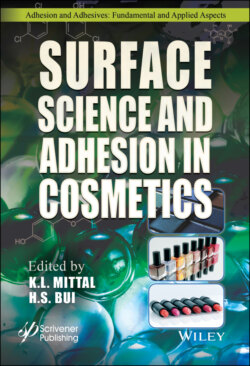Читать книгу Surface Science and Adhesion in Cosmetics - Группа авторов - Страница 38
2.3.1 Factors Affecting Oil-Wax Structures: Wax Type 2.3.1.1 Non-Natural Waxes
ОглавлениеTo improve the structure of lipstick, Yoshida and coworkers [16] discovered that when a small amount of branched paraffin wax was added to a linear paraffin wax in ester oil, neopentyl glycol dicaprate, the hardness of the lipstick was enhanced. This behavior was from the reduction of the wax crystal size making the gel harder, but at the same time the crystal density decreased making the gel softer. To prevent the reduction of wax crystal density, they developed a branched wax, bis(polyethylenyl)-tetramethyldisiloxane, in which polyethylene (PE) units were at both ends. With the tetramethyldisiloxane at the center, it suppressed the crystal growth, but the PE end-units prevented the decrease of crystal density. Therefore, by adding this branched wax in the n-paraffin wax, the gel hardness increased dramatically. The benefit of this branched wax was to improve the hardness of the lipstick with lower amount of wax, which enhanced the gloss and gave creamy/smooth texture upon application.
To increase the hardness of oil-wax gel in a lower polarity oil, Imai and coworkers [17] blended 2 paraffin waxes with different carbon chain lengths (C30 and C32) in 1 to 1 ratio, and the gel was harder and rougher compared to the single paraffin wax gel, but still exhibited a single crystal phase as determined from X-ray diffraction (XRD). However, the blend of 2 paraffin waxes of carbon chain lengths C32 and C28 caused a macro-phase separation, resulting in a softer gel than from the blend of C30/C32 and the surface of crystals was smooth. This phenomenon was explained by the disorder of lamellar structures caused by the crystallization of 2 waxes with different carbon chain lengths as observed by SEM, small angle X-ray scattering (SAXS) and XRD measurements.
Park and Ha [18] investigated the effect of lattice structure of wax crystals on the glossiness of wax-oil systems. Adding a branched microcrystalline wax with lower Tm to ceresin wax in polyglyceryl-2-tri-isostearate oil reduced the hardness of wax-oil gels, enhancing the gloss. The reduction of wax-oil gel hardness was due to the enlarged and loose lattice structure of ceresin wax crystals in the presence of branched wax, and decreased crystal density as observed by SEM. However, when adding n-paraffin wax with lower Tm to ceresin wax, the dense lattice structure of wax crystals did not change much; hence, the hardness of wax-oil gels was slightly reduced, resulting in a low glossiness from the wax-oil gels.
Similarly, Miyazaki and Marangoni studied the structure and mechanical properties of straight-chain paraffin wax (Tm= 72°C-74°C) and polyethylene wax (Tm= 83°C-90°C) in the select oil isotridecyl isononanoate [19]. Their results showed that PE wax-oil system had a higher Young’s modulus and yield stress than the paraffin wax- oil system because the size of the PE wax cells was smaller as observed by cryo-SEM.
For a long lasting color lipstick, the crystallization of wax from the formulation containing silicone resin and volatile oils posed a challenge to create rigid structure for a solid lipstick. In the long-wear lipstick formulation, the volatile oil, isododecane, has low viscosity and is a good solvent for PE wax. In order to create a rigid solid form, high amount of PE wax is used to solidify the formulation. As a result, the attributes of wear, spreadability and sensorial perception of the solid lipstick are sacrificed because the solid lipstick is too hard to give a good deposit and smooth application. To solve this problem, the blend of high melting and low melting PE waxes is used [20]. Furthermore, adding a small amount of high melting alcohol wax to the blend of PE waxes helped to achieve the right structure of the lipstick with good deposit and maintaining long-lasting color.
Nicholas and Brooks reported the use of hyperbranched polyalphaolefin waxes (HBWs) to enhance the hardness of lipstick [21]. Increasing the molecular weight and branch length, HBW can exhibit from liquid to high melting solid wax. When blending a small amount of short branch length HBW (Tm= 41°C) with high melting point polyethylene wax in volatile oil, isododecane, the hardness of the lipstick was enhanced. The SEM showed that adding HBW to PE wax created more uniform and smaller crystal structures. They concluded that the HBW acted as a compatibilizer between isododecane and PE wax, resulting in smaller crystal sizes and enhancing both the stability and hardness of the lipstick.
Kose [22] developed a new technology to control the ultra-fine structure of lipstick in order to deliver high shine and smooth application for consumers. They controlled the interior wall of wax structures, which is known as card-house structure, by 200 times smaller than the existing wax-oil gels. By utilizing amorphous polypropylene as a thin amorphous layer between the crystalline phases, the coating of applied lipstick became more uniform and shiny on the lips.
